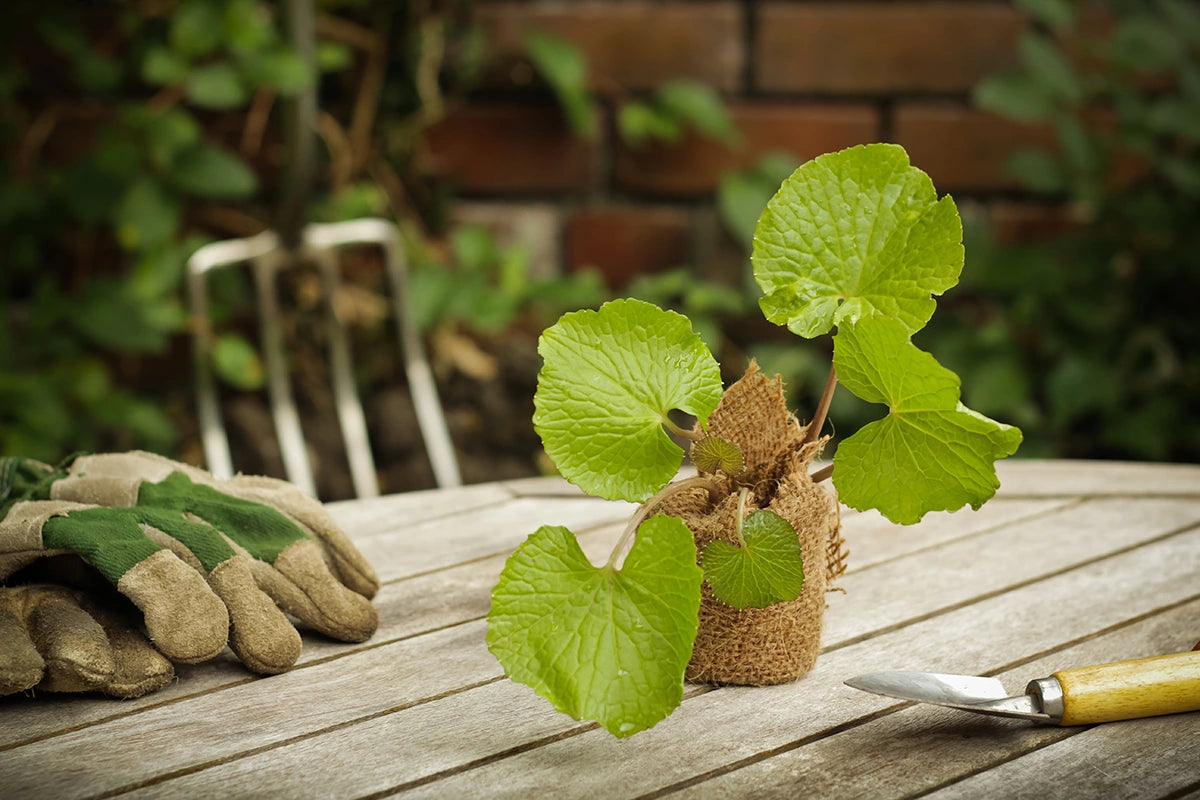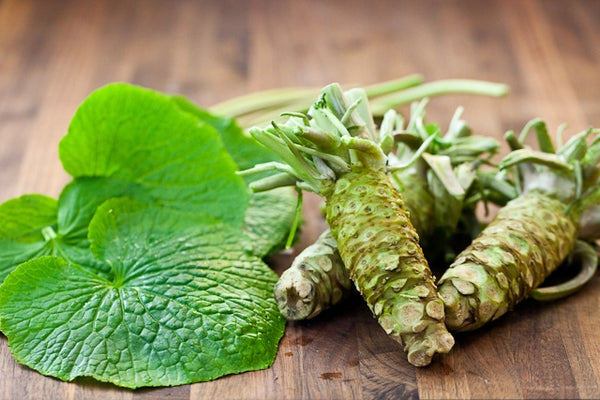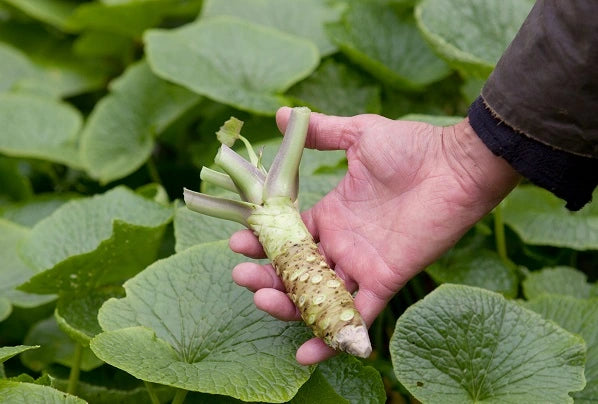
Wasabi, often known as Japanese horseradish, is a plant of the Brassicaceae family. It is renowned for its strong, pungent flavour that adds a fiery zest to sushi and sashimi.
Growing wasabi at home can be quite a rewarding challenge since the plant has specific growing conditions that are typically found in misty, mountainous regions of Japan.
With the proper care and environment, however, it is possible to cultivate and enjoy fresh, home-grown wasabi.
Here's how we recommend growing your wasabi plant - and how we do it at The Wasabi Company!

How to grow your wasabi plant
Where to plant wasabi
When your wasabi plant arrives, we recommend that you plant it first into a 9cm (3") pot with compost. This will ensure that the plant establishes a good root structure. Then, you can plant it out 4-5 weeks later.
Growing wasabi in a container is possible, with consistently damp (not soaking) soil, and a top dressing of compost or general-purpose plant food for nutrition. We'd recommend a 9 litre pot as a minimum size.
When planting wasabi outside, the soil should be fertile and well draining. Although wasabi likes plenty of water, it will not like to be sat in a puddle for extended periods.
If you have a pond, your wasabi plant will be happy on the edge, provided shade is available. Plant so that the crown of the plant is not covered, but remains slightly above the soil. This will allow new leaves to emerge unhindered.
Wasabi is accustomed to shady river banks high in the Japanese mountains so has evolved to survive in very low light levels. This means that your plant will need protecting from the summer sun with heavy shade. Planting under over-hanging branches, behind a tall bush or on the shaded side of a fence or wall are all good spots.
Caring for your wasabi plant
Wasabi is not a very demanding plant, and pests and disease are unlikely. The occasional aphid or mildew may be seen, but these are unlikely to threaten more than a few leaves.
Slugs will eat wasabi leaves, so should be deterred and removed. A well-established wasabi plant will recover from a slug attack.
If your shade isn't sufficient in summer, and you notice yellowing leaves, provide more shade by growing a tall plant on the sunny side or fixing a piece of shade cloth above the wasabi.
Wasabi loves its summers cloudy and cool - so if the weather is dull, you can take solace in the fact that the wasabi will be thriving!

Growing wasabi
When you grow wasabi successfully, you'll notice beautiful, large heart-shaped leaves 60cm high and a meter wide from the mature plant. This makes for an incredibly striking feature in a shady spot! These leaves will die back in winter, as the plant's energy travels down into the rhizomes that will be forming at the base of the stems.
Rhizomes are stems, rather than the wasabi root. They allow the plant to survive through winter - down to –5ºC - and re-grow wonderfully in the spring. To protect your wasabi plant from the cold, you could cover the crown of the plant with some fleece.
Patience is a virtue with wasabi, and the reward of harvesting and grating your own fresh wasabi paste will be all the sweeter for the two years it can take to yield the famously pungent rhizomes.
Harvesting wasabi
Wasabi's leaves and stems are all edible! Whilst you're waiting for the rhizomes to form, you can pick these in small numbers throughout spring or summer to spice up a salad.
In March and April, long stems holding a cluster of delicately scented white wasabi flowers will appear. You can eat these raw, or even fry them in tempura batter if you're out to impress.
To harvest your wasabi rhizomes, pull the whole plant and carefully separate the rhizomes from the base.
Several rhizomes weighing 100g and more will provide you with a bountiful and eye-watering harvest to share with friends over sushi, or any of the delicious and original recipes we've created. Check out our recipes containing wasabi here!
To establish your next wasabi plant, select plantlets (growing shoots) and re-plant.

Buy authentic wasabi plants from The Wasabi Company!
We're wasabi-growing experts here at The Wasabi Company! In fact, we think we hold the British record at 377g for a single rhizome.
So, where better to buy your wasabi plants than from us? Get your first Wasabi Plant here today.
Or, if you fancy starting out with all the necessary tools, try our Fresh Wasabi Pro & Grow Kit. This also makes a fab gift for all the foodies in your life.
Finished growing your wasabi plant? Here's how to prepare fresh wasabi paste.
This is your guide to preparing fresh wasabi paste directly from the wasabi rhizome. If you want to experience the gorgeous, unique pungency of fresh wasabi, we'd highly recommend grating it straight from the fresh rhizome!
You've probably had wasabi before that's just been made out of horseradish and green food colouring. Now, it's time for the real deal.
Follow the instructions below to produce an authentic, fresh wasabi paste with unmistakable sweet pungency of real wasabi.
- Peeling is not essential, but any dark patches of skin can be removed for a cleaner paste. Remove the stems first; this will reveal the greenest, sweetest wasabi.
- Using a wasabi grater, grate in a circular motion; this effectively advances the wasabi to a fine paste. Keep grating until you have as much as you need. Don’t grate too much in one go as it will lose its flavour after 15 – 20 minutes - and you can always grate more.
- Use the brush to remove the freshly grated wasabi from the grater to a wooden or ceramic surface as a steel surface speeds the oxidisation process. Gather into a ball and let it rest at room temperature for up to 5 minutes for the flavour to develop. Then, it’s ready to serve.
- If you do not have a wasabi grater, it is essential you grate the wasabi into a paste to generate the best flavour and the all-important pungent heat. Microplane or parmesan graters will help to achieve the paste but some valuable wasabi will be left behind on the teeth of the grater. We do not recommend using a normal cheese grater as you are looking to achieve a much finer paste than these are capable of producing. Wasabi graters are available to purchase here.

